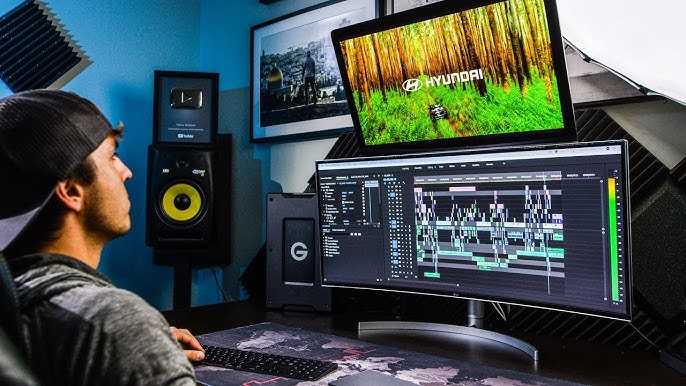To configure your HDR monitor for editing, start by setting your monitor’s color profile to HDR mode, calibrate it correctly for accurate colors, and adjust brightness and contrast for optimal viewing. Use your editing software’s HDR settings to match your monitor’s capabilities, ensuring your workspace is properly tuned for precise color grading. Finally, always verify your setup with a test clip to confirm that the HDR content is displayed correctly.
Mastering HDR monitor setup is key for professional video editing. To do this, you need to ensure your monitor is in HDR mode, calibrate it using specialized tools, and fine-tune the brightness, contrast, and color settings. Matching your monitor’s output with editing software’s HDR parameters guarantees accurate color representation. In this article, we’ll guide you through these essential steps, helping you achieve flawless HDR edits with confidence. Whether you’re new to HDR or looking to optimize your workflow, these tips will help you get the most out of your HDR monitor.
How to Configure HDR Monitor for Editing
Understanding HDR and Its Benefits for Editing
High Dynamic Range (HDR) enhances the contrast and color range of your monitor, making your editing process more accurate. It allows you to see details in both the brightest and darkest parts of your footage. Proper HDR calibration ensures your videos look great across all screens and platforms.
Assessing Your HDR Monitor Capabilities
Before configuring, check what HDR features your monitor has. Look for specifications like HDR10, Dolby Vision, or HLG support. Ensure your monitor can display high brightness levels, typically above 600 nits, for true HDR performance.
Connecting Your HDR Monitor Correctly
Use high-quality HDMI 2.0 or DisplayPort cables to connect your monitor. These cables support high bandwidth needed for HDR. Make sure your graphics card also supports HDR output to prevent compatibility issues.
Configuring Operating System Settings
Set your computer’s display settings to enable HDR. On Windows, go to Display Settings, select your monitor, and toggle the HDR option on. On macOS, navigate to System Preferences, then Displays, and enable HDR if available. This step ensures your system recognizes and utilizes HDR capabilities.
Calibrating Brightness and Contrast
Adjust the monitor’s brightness to match typical viewing environments, usually around 1000 nits for HDR editing. Set contrast settings so that bright highlights do not blow out and shadows remain detailed. Use built-in calibration tools or professional calibration hardware for precision.
Fine-Tuning Color Settings
Set the color space to a standard like Rec. 2020 or DCI-P3, which are common in HDR workflows. Adjust gamma settings to 2.4 or 2.6, depending on your room lighting. Proper color calibration ensures your footage appears as intended.
Utilizing Calibration Tools and Software
Invest in hardware calibration tools such as a colorimeter or spectrophotometer to achieve accurate color reproduction. Use software provided by your monitor manufacturer or third-party solutions to fine-tune color accuracy. Regular calibration helps maintain consistent results.
Configuring Editing Software for HDR
Ensure your editing software supports HDR workflows, such as Adobe Premiere Pro, DaVinci Resolve, or Final Cut Pro. Set project settings to HDR color space and enable high dynamic range preview modes. This ensures your edits accurately reflect the final output.
Creating a Suitable Workspace Environment
Work in a dimly lit room with controlled lighting to prevent glare and reflections. Use neutral-colored walls and avoid colored light sources that can affect your perception of colors. This setup helps you judge colors and contrast more accurately.
Monitoring and Adjusting HDR Settings During Editing
Regularly check your HDR monitor’s settings as you work. Use built-in tools or external test charts to verify accuracy. Adjust brightness, contrast, and color settings if your monitor drifts or if you switch between different projects.
Testing Your HDR Setup
Use HDR test videos or images to evaluate your calibration. Look for details in highlights and shadows, ensuring no clipping occurs. Confirm that the colors are vivid but natural and that the overall image matches your expectations.
Additional Tips for Optimal HDR Editing
- Maintain a consistent workflow by saving calibration profiles.
- Avoid changing ambient lighting during editing sessions.
- Stay updated with monitor firmware and software drivers for best performance.
- Consider using reference materials and test patterns for ongoing calibration checks.
Related Topics to Explore
- Best HDR video editing software for 2023
- Differences between HDR standards: HDR10 vs Dolby Vision
- Color grading tips for HDR content
- Understanding gamma and contrast in HDR workflows
Configuring an HDR monitor for editing requires attention to detail and proper calibration. Following these steps ensures you get the most accurate and consistent results in your video projects. Always keep your calibration tools up-to-date and revisit your settings periodically to maintain optimal performance.
Win11 – Calibrate your HDR! (How-To)
Frequently Asked Questions
What are the initial calibration steps required for an HDR monitor used for editing?
Start by accessing the monitor’s calibration settings and selecting the HDR profile. Use a high-quality calibration tool to measure the display’s luminance, color accuracy, and gamma. Adjust the brightness, contrast, and color temperature according to the manufacturer’s recommendations for HDR workflows. Ensure that the monitor’s firmware is up to date to support the latest HDR standards. Proper calibration ensures that the colors and luminance levels are accurate for editing HDR content.
How do I set the correct color space and bit depth on my HDR monitor for editing?
Access your monitor’s menu and set the color space to a standard such as BT.2020 or DCI-P3, depending on your project requirements. Enable a high bit depth, ideally 10-bit or higher, to handle the subtle gradations in HDR footage. Confirm that your graphics card and editing software support these settings and are configured to output the corresponding color profiles. This approach maintains color accuracy and prevents banding during color grading.
What are the optimal display settings for HDR editing in different software applications?
Configure your editing software to recognize and utilize the monitor’s HDR capabilities, enabling features like HDR grading tools. Adjust the display gamma and luminance settings within the software to match the monitor’s calibrated profile. Use preview modes to verify how images will appear on other HDR devices. In some cases, enabling specific HDR settings in your OS or GPU control panel enhances compatibility and ensures consistent image quality across applications.
Final Thoughts
Configuring your HDR monitor for editing involves adjusting brightness, contrast, and color settings to suit your workflow. Use the monitor’s built-in menu to set accurate gamma and color profiles, ensuring true-to-life visuals. Calibrate your display regularly with professional tools to maintain optimal quality. Remember, how to configure hdr monitor for editing directly impacts your editing precision and final output quality.

I follow the latest trends in smart devices, portable monitors, and gaming accessories. My goal is to provide real-world insights that help readers make smarter tech decisions.






